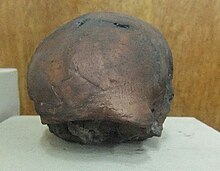
Back Mojokerto-kind Afrikaans طفل موجوكيرتو Arabic Niño de Mojokerto Spanish Enfant de Mojokerto French Anak Mojokerto ID Cranio di Mojokerto Italian Ребёнок из Моджокерто Russian
 | |
| Catalog no. | Mojokerto 1 Perning 1 |
|---|---|
| Common name | Mojokerto child |
| Species | Homo erectus |
| Age | 1.43–1.49 million years |
| Place discovered | Mojokerto, Indonesia |
| Date discovered | 1936 |
| Discovered by | Andojo Ralph von Koenigswald |
The Mojokerto child, also known as Mojokerto 1 and Perning 1, is the fossilized skullcap of a juvenile early human. It was discovered in February 1936 near Mojokerto (East Java, Indonesia) by a member of an excavation team led by Ralph von Koenigswald. Von Koenigswald first called the specimen Pithecanthropus modjokertensis but soon renamed it Homo modjokertensis because Eugène Dubois – the discoverer of Java Man, which was then called Pithecanthropus erectus – disagreed that the new fossil was a Pithecanthropus. The skullcap is now identified as belonging to the species Homo erectus.
The Mojokerto child has been the most controversial of the early human fossils that have been found in Indonesia.[1] Its date and even the exact site of its discovery have been widely disputed. First thought to be less than 1.00 Ma (million years old), in 1994 it was claimed, based on argon–argon dating, which was then a new dating method, that the skull was around 1.81 Ma old. The authors of the paper, Carl C. Swisher III and Garniss Curtis, argued that this date had wide implications for our understanding of the first human migrations "Out of Africa". In the early 2000s, however, new archival and scientific research identified the precise layer from which the fossil was excavated in 1936 and showed conclusively that the fossil's earliest possible date was 1.49 Ma.
- ^ Dennell 2009, p. 155.
© MMXXIII Rich X Search. We shall prevail. All rights reserved. Rich X Search